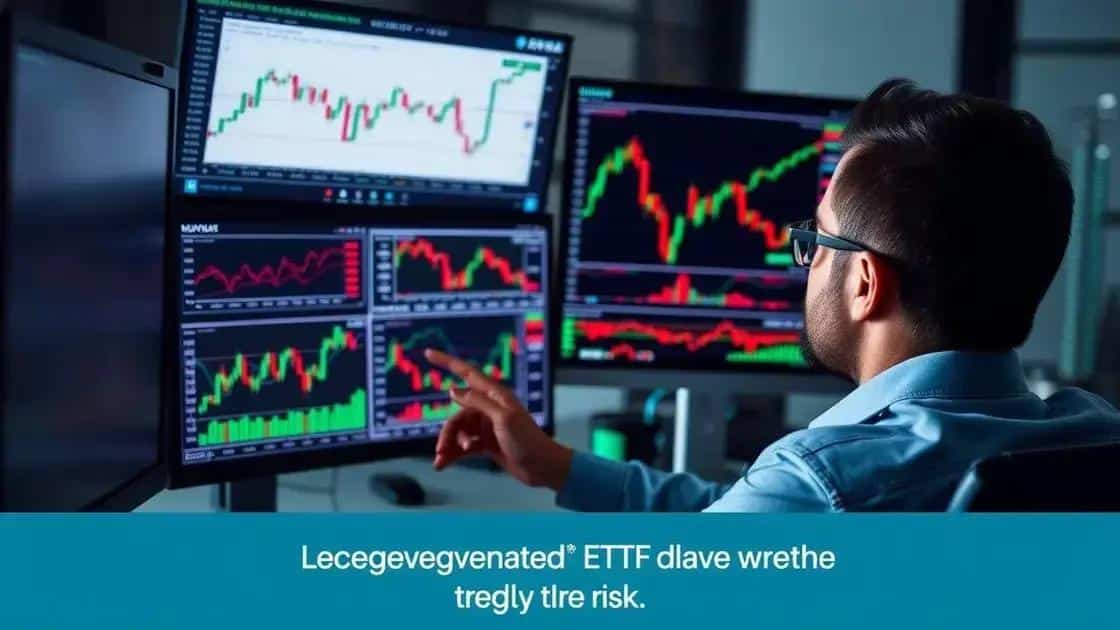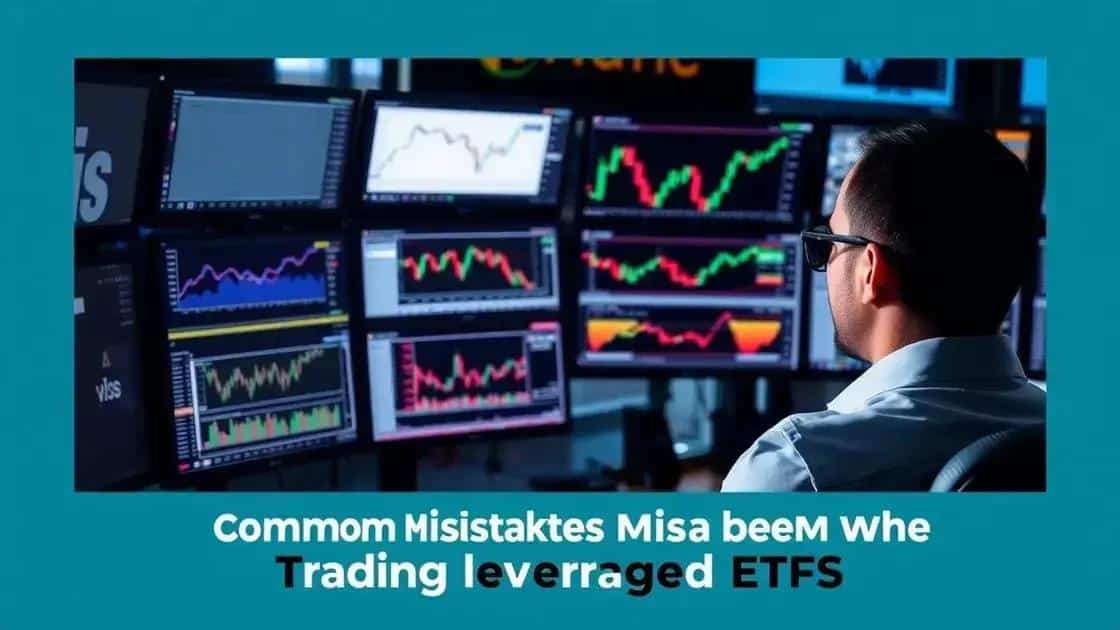Leveraged ETF risk management practices: safeguard your investment

Leveraged ETF risk management practices involve regular monitoring, diversification, setting stop-loss orders, and educating oneself to navigate the inherent market volatility and amplifying effects of these financial instruments effectively.
Leveraged ETF risk management practices are crucial for investors looking to maximize their returns while minimizing potential losses. Have you ever wondered how to effectively navigate the complexities of leveraged ETFs? In this article, we delve into strategies to safeguard your investments.
Understanding leveraged ETFs
Understanding leveraged ETFs is crucial for anyone looking to invest wisely. These investments aim to amplify the returns of an underlying index, making them attractive to growth-oriented investors. However, they come with unique risks and strategies that one must know before diving in.
What are leveraged ETFs?
Leveraged ETFs are exchange-traded funds that use financial derivatives and debt to boost the returns of an underlying index. They aim for daily returns that are a multiple of the index, often 2x or 3x. This means if the index rises by 1%, a 2x leveraged ETF aims to rise by 2%.
Key features of leveraged ETFs
While leveraged ETFs offer potential for higher returns, it’s essential to understand their features:
- Daily rebalancing: Most leveraged ETFs reset daily, which means they aim to maintain their leverage over short horizons.
- Increased volatility: The use of leverage increases the volatility of returns, which can lead to larger losses as well.
- Suitability for short-term trading: Leveraged ETFs are generally more suitable for traders rather than long-term investors.
As you consider investing in leveraged ETFs, be clear on your investment goals. These funds can amplify both gains and losses, which can significantly impact your portfolio. Think about how much risk you can handle, and always conduct thorough research.
Many investors wonder about the long-term implications of using leveraged ETFs. The truth is, over time, the effects of compounding can lead to unexpected outcomes. For example, a series of small losses can erode capital more quickly than expected.
In summary, while leveraged ETFs provide exciting opportunities for growth, understanding their mechanics and risks is vital for making informed decisions. Always consider your risk tolerance and investment strategy before diving in.
Key risks associated with leveraged ETFs

When investing in leveraged ETFs, it is essential to be aware of the key risks involved. These investments offer the potential for high returns, but they also come with substantial risks that can affect your overall portfolio.
Increased volatility
Leveraged ETFs are designed to amplify the performance of an underlying index, which means they can experience more significant price swings. This increased volatility can lead to larger losses than traditional ETFs, making it vital for investors to monitor their investments closely.
Compounding effects
One of the most critical risks is related to the compounding effect over time. Since leveraged ETFs reset daily, their performance can diverge from the expected return in volatile markets. For instance, in a fluctuating market, the ETF could lose value even if the underlying index is stable over the same period.
- Short-term nature: Leveraged ETFs are generally better suited for short-term trading rather than long-term holding strategies.
- Maximum loss potential: Investors can run the risk of losing their entire investment if the underlying index falls sharply.
- Market timing: Successfully using leveraged ETFs often requires precise market timing, which can be challenging for many investors.
Understanding these risks is crucial before you decide to invest. Always perform thorough research and, when necessary, consult a financial advisor. Being informed can help you navigate the complexities associated with leveraged ETFs effectively.
Ultimately, while leveraged ETFs may offer lucrative opportunities, recognizing their risks can empower you to make better investment choices. Make sure you are prepared for the volatility and complexities that come with these types of funds.
Best practices for managing leveraged ETF risks
To navigate the complex world of leveraged ETFs, knowing the best practices for managing leveraged ETF risks is vital. By implementing effective strategies, you can work toward safeguarding your investments while aiming for potential gains.
Regular monitoring
One of the most critical practices is to regularly monitor your investments. Due to the inherent volatility in leveraged ETFs, frequent check-ins can help you react swiftly to market changes. Setting alerts or using a trading platform to keep track of price movements is highly advisable.
Diversification of your portfolio
Diversification can mitigate risks associated with leveraged ETFs. By spreading your investments across various asset classes, you reduce the impact of a poor-performing asset on your overall portfolio. Consider incorporating traditional ETFs, stocks, and bonds alongside your leveraged investments.
- Limit your exposure: Determine how much of your portfolio should be allocated to leveraged ETFs to avoid overexposure.
- Set stop-loss orders: These orders can automatically sell your ETFs if they fall below a specified price, helping limit potential losses.
- Understand your risk tolerance: Always assess your risk tolerance before investing in leveraged ETFs and adjust your investment strategy accordingly.
Education is another essential aspect of managing leveraged ETF risks. Stay informed about market trends and updates related to leveraged ETFs. Engaging with educational resources can enhance your decision-making process. Furthermore, consider using simulations or paper trading to practice strategies without risking real capital.
Ultimately, being proactive and educated can help you navigate the complexities of leveraged ETFs effectively. Adopting these best practices can position you to manage risks more successfully and strive for the gains you desire.
Common mistakes to avoid with leveraged ETFs

Investing in leveraged ETFs can be exciting, but many investors make common mistakes that can lead to substantial losses. Recognizing these pitfalls is essential for successful trading.
Ignoring the compounding effect
One major mistake is ignoring how the compounding effect can work against you. Since leveraged ETFs reset daily, prolonged holding in a volatile market can lead to unexpected losses. It might seem like a great idea to hold onto a leveraged ETF for the long term, but over time, compounding can create discrepancies between the ETF and the underlying index.
Overtrading your investments
Another mistake is overtrading. Frequent buying and selling in an attempt to capitalize on short-term fluctuations can rack up high transaction fees and taxes, eating into your profits. It’s essential to have a clear strategy rather than reacting emotionally to market movements.
- Setting unrealistic expectations: Many investors expect to make quick profits, leading to poor decision-making.
- Failing to use stop-loss orders: Without these protective measures, you risk significant losses if the market turns against you.
- Neglecting to research: Understanding the underlying index and broader market trends is crucial before investing.
Moreover, many traders forget about the importance of diversification. Relying solely on leveraged ETFs can expose your portfolio to higher risks. Spreading investments across traditional funds and asset classes can mitigate this risk. You should also obtain guidance from reliable sources or professionals if you are new to the world of leveraged ETFs.
Finally, consider your risk tolerance carefully. Many investors underestimate the risks involved and find themselves in a tricky situation during market downturns. Always be sure to align your investments with your overall financial goals.
FAQ – Frequently Asked Questions about Leveraged ETFs
What are leveraged ETFs?
Leveraged ETFs are exchange-traded funds that aim to amplify the returns of an underlying index, typically using financial derivatives.
What are the risks of investing in leveraged ETFs?
The risks include increased volatility, compounding effects that can lead to unexpected losses, and the potential for significant financial loss if the market moves against you.
How can I effectively manage risks with leveraged ETFs?
Regularly monitor your investments, diversify your portfolio, set stop-loss orders, and educate yourself about market trends.
What common mistakes should I avoid when investing in leveraged ETFs?
Avoid overtrading, ignoring the compounding effect, setting unrealistic expectations, and failing to research the underlying assets.





